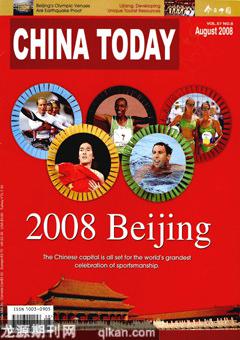The Changes to Chang’an Avenue
By staff reporter YI LI

BUILT in the 15th century, Changan Avenue (Avenue of Eternal Peace) forms Beijings ancient east-west axis. It was only 3.7 kilometers long when it was first built, running from Dongdan to Xidan. Through the centuries, the street has been pushed east to Tongzhou District, and west to Shijingshan District. It is now a wide boulevard 46 kilometers long.
Many symbols of both ancient and modern China can be found along its length, including Tiananmen Gate, Tiananmen Square, which is the heart of Changan Avenue, the Great Hall of the People, the Chinese governments office compound of Zhongnanhai, various museums and theaters, several major commercial areas and metro stations.
Historical Sites
Dongjiaomin Alley is located to the east of Chairman Mao Zedong Memorial Hall on Tiananmen Square. It was the embassy area during the Qing Dynasty (1644-1911). Therefore, a variety of grand Western-style buildings can be found there. Today, it is an ideal place to enjoy peace and quiet.
The Beijing Ancient Observatory, standing to the south of Jianguomen Overpass, was built in 1442, 223 years earlier than the Royal Observatory in Greenwich, England. It has an observation history of nearly 500 years, from 1442 to 1929, which is a very long time in the world history of science. Instruments like the equatorial armillary sphere and the quadrant were made during the Qing Dynasty, and still work today.
Wangfujing

It is said Wangfujing was named after a nearby well. Imperial administrations and residences of princes assembled in this area over 700 years ago. Gradually, it became a business center of Beijing. In 1983, the local government and sponsors from Hong Kong invested a large sum of money to rebuild this commercial street.
When the Oriental Plaza, which is at the south entrance of Wangfujing, was built in 1997, human fossils 20,000 years old were unearthed. It is considered to be as significant a discovery of ancient human remains as those found at the Peking Man site in Zhoukoudian. A museum displaying the fossils is in the basement of the Oriental Plaza. At the same time, sculptures and paintings in the museum recount the story of Wangfujings early inhabitants. Above the museum stands a complex comprising 13 buildings, including offices, a hotel, a shopping mall and a recreation center.
Called “Gold Street,” the two-kilometer-long Wangfujing contains hundreds of shops and stores. One must not miss Beijing Department Store, Sun Dong An Mall, and the Arts and Crafts Plaza. Moreover, a beautiful fountain, flowers and lighting make the street lively and colorful. It is the sister-street of Ginza in Tokyo, the Champs Elysees in Paris, Manhattan 5th Avenue in New York, and Arbat Street in Moscow.
A high-level digital cinema is situated to the east of Wangfujing. It was built by a Belgian company, and isregarded as one of the most advanced cinemas in the world.
The Fortune
District

The CentralBusinessDistrict (CBD) and Financial Street are two prosperous business zones in Beijing. In 1998, the government started to construct the CBD in a four-square-kilometer area around Jianguomen on Changan Avenue. Today, 117 of the worlds top 500 enterprises have set up branches here.
Its economic function is to be an international CBD, integrating business offices, an exhibition hall, hotels, residences and entertainment venues to be the regional headquarters and operations management centers for financial, insurance, telecom and information consultation companies.
Financial Street covers an area of one square kilometer. Since the 13th century, this area has been a busy trade center of Beijing. Throughout the centuries, countless businessmen have become rich here.
Rebuilt in 1993, the area has attracted 100 financial institutions, including five foreign banks, like the Bank of New York and the Asian Development Bank. Concentrating half of the nations financial assets, this “Chinese Wall Street” represents Chinas economic core power.

